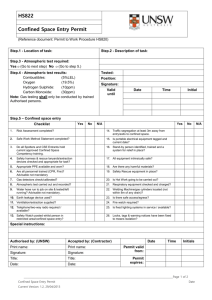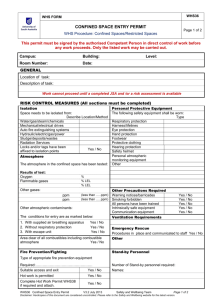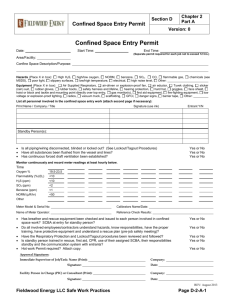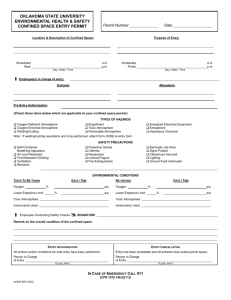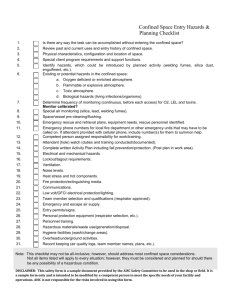Operations Division OPERATING POLICY AND PROCEDURE PP/OP 08.10:
advertisement
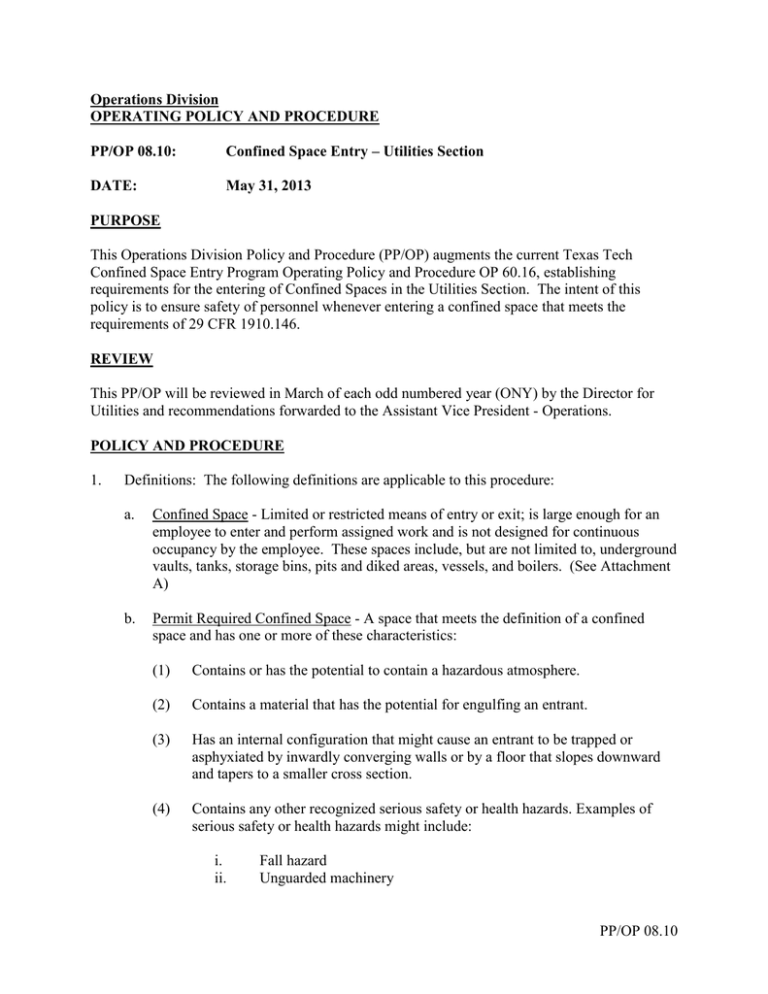
Operations Division OPERATING POLICY AND PROCEDURE PP/OP 08.10: Confined Space Entry – Utilities Section DATE: May 31, 2013 PURPOSE This Operations Division Policy and Procedure (PP/OP) augments the current Texas Tech Confined Space Entry Program Operating Policy and Procedure OP 60.16, establishing requirements for the entering of Confined Spaces in the Utilities Section. The intent of this policy is to ensure safety of personnel whenever entering a confined space that meets the requirements of 29 CFR 1910.146. REVIEW This PP/OP will be reviewed in March of each odd numbered year (ONY) by the Director for Utilities and recommendations forwarded to the Assistant Vice President - Operations. POLICY AND PROCEDURE 1. Definitions: The following definitions are applicable to this procedure: a. Confined Space - Limited or restricted means of entry or exit; is large enough for an employee to enter and perform assigned work and is not designed for continuous occupancy by the employee. These spaces include, but are not limited to, underground vaults, tanks, storage bins, pits and diked areas, vessels, and boilers. (See Attachment A) b. Permit Required Confined Space - A space that meets the definition of a confined space and has one or more of these characteristics: (1) Contains or has the potential to contain a hazardous atmosphere. (2) Contains a material that has the potential for engulfing an entrant. (3) Has an internal configuration that might cause an entrant to be trapped or asphyxiated by inwardly converging walls or by a floor that slopes downward and tapers to a smaller cross section. (4) Contains any other recognized serious safety or health hazards. Examples of serious safety or health hazards might include: i. ii. Fall hazard Unguarded machinery PP/OP 08.10 May 31, 2013 Page 2 iii. iv. v. vi. vii. viii. 2. Extreme heat or cold Steam lines or chemical lines Hazardous noise levels Electrical hazards Presence of asbestos Potentially hazardous levels of dust c. Authorized Entrant – Trained personnel designated to enter the confined space. d. Attendant – Trained personnel designated to remain outside the confined space, be in constant communication with the personnel working inside and continuously monitor authorized entrants. e. Entry Supervisor – Individual (Plant Foreman) responsible for determining if acceptable entry conditions are present at a permit space where entry is planned; for authorizing entry, overseeing entry operations, and terminating entry. General Requirements a. Entry Permits Entry Permits will be required if the confined space is not self-ventilating and designed for frequent regular entry. Ventilated sites that are designed for routine entry may require a permit if unusual hazards have developed (For example: large acid spills). (1) Will contain the following information: (a) (b) (c) (d) (e) (f) (g) (h) (i) (j) (k) (l) Environmental Health & Safety (EH&S) test results. Tester’s signature. Name and signature of supervisor who authorizes entry. Name of permit space to be entered, authorized entrant(s), eligible attendants, and individual(s) authorized to be entry supervisors. Purpose of entry and known space hazards. Measures to be taken to isolate permit spaces and eliminate or control space hazards; i.e., locking out or tagging of equipment and procedures for purging, making inert, ventilating, and flushing permit spaces. Name and telephone numbers of rescue and emergency services. Date and authorized duration of entry. Acceptable entry conditions. Communication procedures and equipment to maintain contact during entry. Special equipment and procedures, including personal protective equipment and alarm systems. Any other information needed to ensure employee safety. PP/OP 08.10 May 31, 2013 (2) b. Page 3 Should include documentation of any problems encountered during an entry operation so that appropriate revisions to the permit space program can be made. Entry Procedure (1) EH&S will be contacted to arrange a date and time for entry. (2) Prior to testing: (3) (a) Tagout will be routed as per Tagout Procedure (PP/OP 08.01) with the exception that DU will initial for final approval. (b) The confined space will be secured, isolated, and danger-tagged and locked as necessary to protect personnel from hazards. (c) If an explosive atmosphere is suspected in the space, have EH&S sample for explosive gas prior to ventilating to prevent explosion from a spark from the fan. (d) Forced ventilation will be applied to the access area and ventilated for 24 hours or until at least 7 air exchanges have been achieved. (Volume of Space/Flow rate of fan) x 7 = length of ventilation time. (e) Supervisors must perform and document the pre-entry planning and training with authorized entrant, standby person, and attendant. When completed contact EH&S. When EH&S arrives: (a) The Plant Foreman will supply a list of authorized entrants and attendants. (b) The Plant Foreman will escort EH&S while the inspection is being completed. (c) EH&S will check the confined space for the following: [1] [2] [3] Oxygen not below 19.5% or greater than 23.5% Lower Flammable Limit (LFL) < 10% Toxic gases or vapors are less than the Permissible Exposure Limit (d) EH&S will fill out the Confined Space Access Permit per TTU/OP. (e) Plant Foreman shall sign as Entry Supervisor. PP/OP 08.10 May 31, 2013 (4) Page 4 Upon approval by EH&S, personnel may now enter the confined space complying with all noted safety requirement. NOTE: If space fails to be cleared for entry for any reason immediately cease all work and notify Utilities Supervisors. c. Termination/Cancellation Procedure (1) The duration of the permit may not exceed the time required to complete the assigned task or job identified on the permit. (2) The Entry Supervisor will terminate entry and cancel the entry permit when: (3) 3. (a) the entry operations covered by the permit have been completed; (b) a condition that is not allowed under the entry permit arises in or near the permit space. (c) after 24 hours from the previous air test Cancelled permits will be retained for at least one year to facilitate the review of the permit-required confined space program. Duties of Plant Personnel a. Duties of Authorized Entrants (1) Complete initial confined space entry training. (2) Know space hazards, including information on the mode of exposure (e.g., inhalation or skin absorption), signs or symptoms, and consequences of the exposure. (3) Use appropriate personal protective equipment properly (e.g., face and eye protection and other forms of barrier protection such as gloves, aprons, and coveralls). (4) Maintain communication (i.e., telephone, radio, visual observation) with attendants to enable the attendant to monitor the entrant’s status as well as to alert the entrant to evacuate. (5) Exit from permit space as soon as possible when ordered by an authorized person, when the entrant recognizes the warning signs or symptoms of exposure exists, when a prohibited condition exists, or when an automatic alarm is activated. PP/OP 08.10 May 31, 2013 (6) b. Page 5 Alert the attendant when a prohibited condition exists or when warning signs or symptoms of exposure exist. Duties of Attendants (1) Complete initial confined space entry training. (2) Remain outside permit space during entry operations unless relieved by another authorized attendant. (4) Perform non-entry rescues. (5) Know existing and potential hazards including information on the mode of exposure, signs or symptoms, consequences of the exposure, and their physiological effects. (6) Maintain communication with and keep an accurate account of those workers entering the permit-required space. (7) Maintain communication with a plant operator in the control room. (8) Order evacuation of the permit space when: (9) (a) a prohibited condition exists, (b) a worker shows signs of physiological effects of hazard exposure, (c) a new emergency outside the confined space exists, and/or (d) the attendant cannot effectively and safely perform required duties. Summon rescue and other services during an emergency. (10) Prevent entry by unauthorized persons and inform Authorized Entrants and Entry Supervisor of unauthorized entry. (11) Perform no other duties that may interfere with the attendant’s primary duties. c. Duties of Entry Supervisor (1) Complete initial confined space entry training. (2) Know space hazards including information on the mode of exposure, signs, or symptoms and consequences of exposure. PP/OP 08.10 May 31, 2013 4. (3) Supervisors must perform and document the pre-entry planning and training with authorized entrant, standby person, and attendant. (4) Verify emergency plans and specified entry conditions such as permits, tests, procedures, and equipment before allowing entry. (5) Terminate entry and cancel permits when entry operations are completed or if a new condition exists. (6) Take appropriate measures to remove unauthorized entrants. (7) Ensure that entry operations remain consistent with the entry permit and that acceptable entry conditions are maintained. Emergencies a. b. 5. Page 6 In case of emergencies the Entry Attendant will: (1) Not enter the confined space. (2) Contact the control room operator. (3) Attempt rescue only if it can be done safely from outside the confined space. (4) Remain at the access point if at all possible. The Control Room Operator will: (1) Contact Fire and Rescue at 911. (2) Contact Plant Management. (3) Contact EH&S. Contractors Contractors will be required to adhere to all OSHA regulations concerning “Confined Space Entry.” Texas Tech University will supply information as necessary to determine confined space requirements. Contractors will be required to perform their own air samples and supply their own entry attendants and safety equipment. 6. Training a. The Utilities Section will provide training so that affected employees acquire understanding, knowledge and skills necessary for the safe performance of their duties. PP/OP 08.10 May 31, 2013 Page 7 b. Training will be conducted prior to employee’s first confined space assignment or before there is a change in assigned duties. c. Refresher training will be conducted annually or when there is a change in permit space operations, the employer has reason to believe there are deviations from the permit space entry procedures, or there are inadequacies in the employee’s knowledge or use of the procedures. d. The training will be sufficient enough to establish employee proficiency for compliance with this policy and procedure. e. All required training will be documented and the employer will certify that the training has been accomplished. The certification will contain each employee’s name, the signature of the trainer, and the dates of the training. RESPONSIBILITIES POSITION Director for Utilities SECTION MONTH Review March (ONY) Dale Townsley APPROVED: _______________________________ Digitally signed by Dale Townsley DN: cn=Dale Townsley, o=Utilities, ou=Phyical Plant, email=dale.townsley@ttu.edu, c=US Date: 2013.05.22 15:16:05 -05'00' Reviewer Hugh E Cronin APPROVED: _______________________________ Assistant Vice President - Operations Digitally signed by Hugh E Cronin DN: cn=Hugh E Cronin, o=Ops Div, ou=TTU, email=hugh.cronin@ttu.edu, c=US Date: 2013.06.11 07:27:46 -05'00' PP/OP 08.10 DESIGNATED CONFINED SPACES Following is a list of known confined spaces, but should not be considered a complete list. Any area meeting the definitions in section 1 of the Confined Space OP (08.10) will be treated as a confined space. CHACP #1 Confined Spaces Entry permit required All tanks including but not limited to: All boiler accesses including steam drums, water drums, firebox, exhaust stack. East and West Condensate Tanks DFT Waste Pit Surge Tank Softeners Polishers RO Tanks Flash Tank Steam Side of Surface Condenser Sand filters North & south acid pits Non permit required Well Vaults RO interconnect vaults CHACP #2 Confined Spaces Entry permit required All tanks including but not limited to: All boiler accesses including the steam drums, firebox, and exhaust stack. Surge Tank DFT Softeners Polishers RO Tanks Flash Tank Steam Side of Surface Condenser Fuel Oil Storage Tanks Chilled Water Expansion Tank Sand filters Non permit required Well Vaults Attachment A PP/OP 08.10 May 31, 2013
